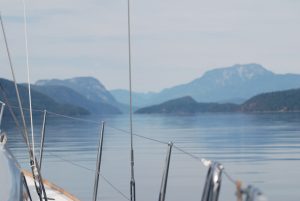If you are planning a holiday sailing in Vancouver, then it is definitely useful to know what sailing experience you need as it can be challenging sailing depending on what time of year you visit.
Sailing Area
The sailing in Vancouver ranges across a wide area, from the Gulf Islands, Desolation Sound, the San Juan Islands and the Sunshine coast, an area that stretches along the Strait of Georgia from Howe Sound to Desolation sound, with many communities to see and superb scenery to enjoy.
Sailing Conditions
Sailing in Vancouver the primary sailing season is from May through to September, however, a great mix of sailing conditions prevails throughout the year, so if you prefer to enjoy some more challenging conditions or varied sailing then you can sail throughout the year.
High Season conditionsFrom April to May, you can expect changeable weather. It is normal to expect strong winds in these spring months, but the weather is warming up and it is a beautiful time of year, with everything coming into bloom.
The Summer months between June to September, you can expect around 8-12 knots of thermally generated winds and relatively dry conditions. Summer is a great time of year for sailing in Vancouver if you are a confident sailor, but have slightly less confidence in varied sailing conditions, as July and August offer light winds and typically lovely weather, so perfect for enjoying the stunning national and provincial parks in the area.
Low Season conditions
October is a very popular time for sailing in Vancouver, before the colder winter weather arrives, but it can be more challenging than the Summer months, so you will need to be a very competent and confident sailor, able to sail in more challenging conditions.
If you are sailing in Vancouver, then you will be be encountering different moorings and anchorages, so you will need to be very competent in mooring up as there are plenty of overnight moorings available for visiting yachtsmen, but it is mainly anchorages, so you will need to be proficient and confident in anchoring in many different bays and and coastal areas.
Tides
There are significant tidal ranges when you are sailing in Vancouver, so it is very useful to understand the tidal ranges in relation to navigation when sailing this cruising area.
News and Updated
Blog : http://www.nanaimoyachtcharters.com/blog/
WordPress : http://www.nanaimoyachtcharters.wordpress.com
Livejournal : http://www.nanaimoyacht.livejournal.com/
Blogspot : http://nanaimoyachtcharters.blogspot.com/
Google Plus : https://plus.google.com/+Nanaimoyachtcharters/
Twitter : https://twitter.com/Nanaimo_YCSS
Pinterest : http://pinterest.com/nanaimoyacht/boards/
Slideshare : http://www.slideshare.net/nanaimoyacht
Facebook : https://www.facebook.com/nanaimoyachtcharters
Blog : http://www.nanaimoyachtcharters.com/blog/
WordPress : http://www.nanaimoyachtcharters.wordpress.com
Livejournal : http://www.nanaimoyacht.livejournal.com/
Blogspot : http://nanaimoyachtcharters.blogspot.com/
Google Plus : https://plus.google.com/+Nanaimoyachtcharters/
Twitter : https://twitter.com/Nanaimo_YCSS
Pinterest : http://pinterest.com/nanaimoyacht/boards/
Slideshare : http://www.slideshare.net/nanaimoyacht
Facebook : https://www.facebook.com/nanaimoyachtcharters





